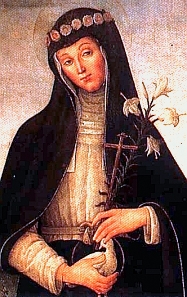Columba of Rieti
Columba of Rieti | |
|---|---|
 | |
| Virgin | |
| Born | 2 February 1467 Rieti,Umbria,Papal States |
| Died | 20 May 1501(aged 34) Perugia,Umbria, Papal States |
| Venerated in | Roman Catholic Church (Dominican Order) |
| Beatified | 25 February 1625 byPope Urban VIII |
| Feast | 20 May |
| Attributes | Dominican tertiary receiving theEucharistfrom a hand reaching down from heaven; Dominican tertiary with a dove, lily, and book, or a wreath of roses,cross,lily, and arosary |
Columba of Rieti,TOSD (2 February 1467 – 20 May 1501) was anItalianreligious sisterof theThird Order of St. Dominicwho was noted as amystic.She was renowned for her spiritual counsel, devotion to theBlessed Sacrament,and fantastic miracles were attributed to her. She wasbeatifiedby theCatholic Churchin 1625.
Life[edit]
Early life[edit]
Columba was born Angelella Guardagnoli, the daughter of a poor family in theUmbriancity ofRieti.Legend states that when she was born,angelsgathered around her house, singing, and that during herbaptism,a dove flew down to the font. From then on, no one referred to her as Angelella, but as Columba(dove).[1]As a small girl, Columba learned to spin and sew repairing the clothes of the local Dominicanfriars.She was educated by Dominicannuns.As a teenager, she prayed to discern her vocation in life and received a vision ofChrist on a thronesurrounded bysaints.She took this as a sign to dedicate herself to God, and so she made a private vow ofchastity,and spent her time in prayer. When it was revealed that her parents had arranged a marriage for her, she cut off her hair and sent it to her suitor as a way of letting him know where her real interest lay.[1]
Religious life[edit]
Columba became a Dominican tertiary at age 19. She was reputedly given to ecstasies, during one of which her spirit toured the Holy Land. She was much sought after as a spiritual counselor. It is said that citizens from the city ofNarnitried to kidnap her so she could be "their" miracle worker, but she escaped. The same townsfolk were later to fight to retain their own townswoman and mystic,Lucy of Narni.[1][2]
Columba fasted regularly.[3]Anorexia mirabiliswas well known in Columba's time, when it was not seen as a medical emergency or mental illness, instead revered as a symbol of one'spiety.Ultimately, the fasting caused her death in 1501, at the age of 34.[4]Additionally, Columba was known to engage in acts designed to cause her physical pain, such as at the wearing of ahairshirtand sleeping onthorns.[5]It's possible that she may have been influenced byCatherine of Siena,an earlier ItalianDominicansaint, who practiced extreme fasting.[6][7]Also, like Catherine, Columba cut her hair short to avoid marriage.[8]
Upon an interior prompting that she should leave Rieti, Columba wandered away, having no concept of where she was going. Along the way she was arrested inFolignoas avagrant.Thebishopthere ordered her to go to Perugia and to found a Third Orderconvent,which she did, but only against the strong objections of the citizens of Foligno and Rieti who wanted her for their own towns.[2]She worked with the poor extensively in Perugia, so much so that her sanctity reportedly incensedLucrezia Borgiafor years. At one point Borgia had even issued a complaint accusing Columba ofpracticing magic.On the other hand,Pope Alexander VI,Lucrezia's father, held Columba in high regard. He consulted her and received a severe admonition to repent from her.[9]
Columba spent eleven years asprioressin Perugia, dying on 20 May 1501, at the age of 34.[2]Legend says that at the moment of her death, her friend and fellow Dominican tertiary,Osanna of Mantua,saw Columba's soul as a "radiance rising to heaven". The whole city turned out for her funeral, which was paid for by the city fathers.[1][9]Columba was beatified on 25 February 1625 byPope Urban VIII,and herfeast dayis celebrated within theDominican Orderon the anniversary of her death.
Notes and references[edit]
- References
- ^abcdJones.
- ^abcAshley.
- ^Weinberg, Cybelle; Cordás, Táki Athanássios; Albornoz Munoz, Patricia (April 2005)."Saint Rose of Lima: an anorexic saint in Latin America?".Revista de Psiquiatria do Rio Grande do Sul.27(1): 51–56.doi:10.1590/S0101-81082005000100006.ISSN0101-8108.
- ^Walker Bynum, Catherine (1988).Holy Feast and Holy Fast: The Religious Significance of Food to Medieval Women.University of California Press. pp. 146–148.ISBN0520908783.
- ^"Miniature Lives of the Saints – Blessed Columba of Rieti".CatholicSaints.Info.2015-02-24.Retrieved2018-10-31.
- ^Farmer, David Hugh (1997).The Oxford dictionary of saints(4. ed.). Oxford [u.a.]: Oxford Univ. Press. p. 93.ISBN0-19-280058-2.
- ^"Bl. Columba of Rieti | Saint Kateri Tekakwitha Parish - Irondequoit, NY".kateriirondequoit.org.Archived fromthe originalon 2018-11-01.Retrieved2018-10-31.
- ^Saint of the day: lives, lessons & feasts.Foley, Leonard, 1913-1994., McCloskey, Patrick. (6th rev. ed.). Cincinnati, Ohio: St. Anthony Messenger Press. 2009.ISBN9780867168877.OCLC318672837.
{{cite book}}:CS1 maint: others (link) - ^abMcNamara 2007.
- Works cited
- Ashley, Benedict M,"Columba of Rieti",Blessed Osanna d'Andreasi and Other Renaissance Italian Dominican Women Mystics,archived fromthe originalon March 20, 2008,retrievedJune 18,2010
- Jones, Terry,"Columba of Rieti",Patron Saints Index,retrievedJune 18,2010
- McNamara, Robert F (20 February 2007),"Bl. Columba of Rieti",Saints Alive,St. Thomas the Apostle Church, archived fromthe originalon 10 December 2007,retrievedJune 18,2010
See also[edit]
External links[edit]
- Herbermann, Charles, ed. (1913)..Catholic Encyclopedia.New York: Robert Appleton Company.
- 1467 births
- 1501 deaths
- People from Rieti
- Lay Dominicans
- Dominican Sisters
- 15th-century Italian Roman Catholic religious sisters and nuns
- Dominican mystics
- Dominican beatified people
- Miracle workers
- Burials in Umbria
- 15th-century venerated Christians
- 16th-century venerated Christians
- 15th-century Christian mystics
- 16th-century Christian mystics
- Visions of Jesus and Mary
